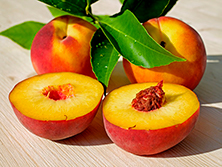A team led by CSIC researchers, including Javier Rojo’s group from IIQ and the Regional University Hospital of Malaga, has developed a compound that, when applied to model mice, has not only protected them from an allergic reaction to peaches, but has also induced tolerance to the corresponding allergen. The research, which has recently appeared in the journal Scientific Reports of the Nature group, has been carried out within the framework of the National Network of Asthma, Adverse and Allergic Reactions (ARADyAL), funded by the Carlos III Health Institute (ISCIII).
The work has been developed within the framework of the National Network of Asthma, Adverse and Allergic Reactions (ARADyAL)
The compound consists of a molecule that combines nine units of the sugar mannose and a peptide derived from the major peach allergen (Pru p 3) in a single, well-defined structure. According to Francisco Javier Rojo, researcher at the Institute of Chemical Research (IIQ) and co-author of the work, the results are very promising, since “the possibility of applying this synthetic strategy to other allergens makes this new compound a very interesting approach to the development of immunotherapies against allergies.”
The study explains that through sublingual immunotherapy, at very low concentrations, the new compound is capable of not only protecting anaphylactic mice from exposure to the allergen, but also maintaining tolerance for at least five weeks after the immunotherapy treatment has ended; which, in addition, does not require the use of any other immune system stimulant or adjuvant.
Rojo points out that food allergies already affect a significant percentage of the population, increasing significantly in recent years in developed countries. “Among food allergies, one of the most prevalent is the allergy to proteins called LTPs, from the English Lipid-Transfer Proteins, which are widely distributed in many foods and are therefore considered panallergens. Among these LTPs, the Pru p 3 protein, common in fruits of species belonging to the Rosaceae family such as peaches, is responsible for food allergies, especially within the Mediterranean area. This type of allergy presents severe symptoms and high cross-reactivity,” concluded the researcher. “Sublingual immunotherapy based on glycosylated nanostructures including Pru p 3-epitope for peach allergy treatment”
Rodríguez M.J., Ramos-Soriano J., Mascaraque A., Torres M.J, Perkins J., Gomez F., Diaz-Perales A., Rojo J., Mayorga C.
Sci. Rep., 2019, DOI: 10.1038/s41598-019-40114-7



